Home Improvement
Viltnemnda in Norway – Facts about Local Wildlife Management

Last October, a moose got hit by a truck on Route E6 near Trondheim. The animal was badly hurt, dragging one leg and bleeding heavily. Police arrived first but called the local Viltnemnda team right away. Three hunters from the municipal wildlife committee showed up within half an hour. They tracked the moose into the woods, found it collapsed behind some trees, and put it down humanely with a single shot. They took measurements, checked for disease, and filed a report with the Norwegian Environment Agency.
This type of emergency happens almost daily somewhere in Norway. Viltnemnda handles around 8,000 wildlife accidents every year across the country’s municipalities. Yet most Americans have never heard of this system. Why does Norway rely so heavily on these local wildlife management committees?
It shows how Norway handles the delicate balance between protecting wild animals and keeping communities safe. These municipal wildlife committees manage everything from the hunting regulations Norway enforces to emergency situations when wildlife crosses into human spaces. They connect national conservation policies with real problems that communities face daily. Learning how it works reveals one of the most effective wildlife governance systems anywhere—a practical model that saves animal lives, prevents human injuries, and honors Norway’s long tradition of sustainable hunting.
What Is Viltnemnda? The Meaning and Legal Foundation
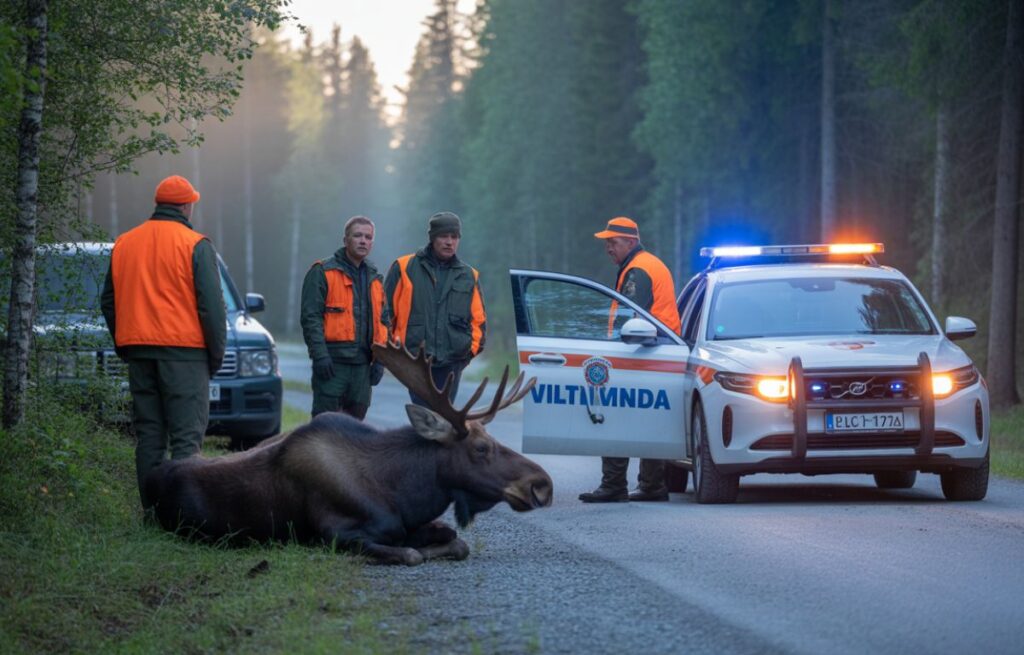
Norway created Viltnemnda because Oslo can’t manage wildlife in 356 different municipalities. A moose hit on a highway in Tromsø needs immediate help, not a permit request that sits on some bureaucrat’s desk for three days.
Origin and Etymology of the Word “Viltnemnda”
The word Viltnemnda comes from two Norwegian terms. “Vilt” means wild animals—the moose, deer, and beavers you find in Norwegian forests. “Nemnda” means a committee with legal power to make official decisions. Put them together and you get “wildlife committee.” Hundreds of years ago, Norwegian farmers and hunters already met up to decide hunting rules and protect animal herds during breeding season. These meetings happened in every valley and village. Nobody forced them to do it—they just knew wildlife management mattered for survival. When Norway wrote formal laws in the 1900s, the government built the Viltnemnda system on top of these old traditions.
Legal Basis – Wildlife Act (Viltloven) and Nature Diversity Act (Naturmangfoldloven)
Two Norwegian laws tell Viltnemnda what they can and cannot do. The Wildlife Act (Viltloven), passed in 1981, says wild animals don’t belong to any person or company—they belong to all Norwegians. This law created Viltnemnda in every municipality and gave them authority to set hunting rules and issue permits. You can read the full law on Lovdata’s website, where Norway posts all its legal codes.
The second law, the Nature Diversity Act (Naturmangfoldloven), came in 2009. It says it must use scientific data when making wildlife decisions, not just guesswork or politics. These laws give municipal wildlife boards real teeth—their rulings on hunting quotas, damage felling, and wildlife permits carry legal weight, and people who ignore them can get fined or prosecuted.
Why Every Municipality in Norway Has a Viltnemnda
Norway split wildlife governance into 356 local chunks because different regions face wildly different problems. Coastal towns deal with seabird colonies nesting on docks. Mountain areas up north handle reindeer and occasional wolves. Farming regions in the south lose crops to deer every fall. If Oslo bureaucrats tried managing all that from one office, nothing would get done. Local Viltnemnda members know their area inside out—which roads get the most moose collisions, which farmers lose lambs to foxes, and where beaver dams back up water every spring. When someone calls about injured wildlife at 2 AM, the municipal wildlife committee can have hunters from the ettersøkskorps on scene in under an hour because they live right there.
Structure and Function – How Viltnemnda Operates in Norwegian Municipalities
It works year-round with legal authority. Members coordinate with police during accidents, contact vets for injured animals, and file population reports with national agencies.
Composition of the Committee and Member Roles
A Viltnemnda usually has five to seven people picked by the municipal council. The chairperson runs meetings and signs hunting permits. The vice-chair assumes control when the chair can’t be present. Regular members have specific expertise—one might be a hunter tracking moose since the 1980s, another might be a farmer who loses sheep to fox every year and a third might be a vet who treats injured wildlife. Larger towns sometimes hire a secretary to manage all of the paperwork and phone calls. Members are appointed for a four-year term and can be re-appointed if the council is satisfied with their expertise and participation.
Appointment Process and Qualifications
The municipal council picks Viltnemnda members after each local election cycle. They look for people with real wildlife experience—not politicians looking for another title. Hunters need valid licenses and years of field experience. Farmers must own land where wildlife causes actual problems. Any biologists or vets need relevant degrees and preferably some background in Norwegian wildlife committee work. The council tries to balance different interests, so you don’t end up with five hunters who just want higher hunting quotas or five conservationists who oppose all damage felling. Most municipalities post open calls for volunteers and interview candidates before making appointments.
Reporting Hierarchy and Coordination with the Municipal Council
It reports directly to the municipal council, which controls its budget and reviews major policy decisions. The committee submits quarterly reports showing how many permits they issued, wildlife accidents they handled, and any conflicts that came up. Big decisions—like changing long-term hunting regulation policies or major habitat protection projects—go to the council for approval. Day-to-day stuff like individual hunting permits or responding to roadkill management in Norway incidents happens without council involvement. The municipal environment department provides administrative support, office space, and access to databases for tracking wildlife population monitoring. This setup keeps it accountable while giving them freedom to act fast during emergencies.
Collaboration with National Agencies and Police
It works closely with several outside organizations. The Norwegian Environment Agency sets national policy guidelines and provides scientific research on animal populations. When it makes decisions about endangered species or protected areas, it checks with the Environment Agency first. Local police handle the emergency response side—when someone hits a moose on the highway, police take the initial call and then contact Viltnemnda to dispatch hunters.
Police also enforce Wildlife Act violations like illegal hunting or permit violations. Some regions coordinate with ettersøkskorps (tracking teams), which are volunteer groups trained to find wounded animals. These partnerships mean Viltnemnda doesn’t work alone—they’re part of a bigger network that handles everything from public safety and animal welfare to climate change and wildlife adaptation strategies.
Core Responsibilities of Viltnemnda
It handles five major duties affecting wildlife and people—from damage compensation to emergency accident response.
Wildlife Damage Control and Compensation Cases
When wild animals destroy crops or kill livestock, Viltnemnda investigates the damage and decides if farmers deserve compensation. A farmer might report that deer ate half his wheat field in August. It sends someone out to photograph the damage, estimate how much crop was lost, and check if the farmer tried fences or other prevention methods first. If the damage is real and significant, they approve compensation payments from municipal funds.
They also issue damage felling permits that let hunters remove specific problem animals. For example, if one aggressive boar keeps breaking through fences and attacking sheep, it might authorize killing just that animal instead of the whole population. This system tries to balance human–wildlife conflict fairly—farmers get help with losses, but not every deer or beaver dies just for eating some grass.
Regulating Hunting Quotas and Permits
Viltnemnda counts animals every year to figure out safe hunting quotas. They check birth rates from spring, winter deaths, and available forest food. Say a town has 200 moose total. It might approve killing 40 bulls and 20 cows that season. Hunters get individual permits listing exact animals allowed—two bull moose in September-October, or five roe deer August-December. The Nature Diversity Act says wildlife belongs to all Norwegians, so it keeps populations healthy for future generations while letting people hunt now.
Handling Injured or Road-Killed Animals (Skadet vilt / Påkjørsel av vilt)
Cars hit moose and deer every single day in Norway. The law says you must call the police right after hitting an animal. Police write down the details and phone Viltnemnda, who sends out ettersøkskorps hunters with tracking dogs. These dogs follow blood through the woods for hours sometimes. Hunters shoot animals that won’t make it. Animals with minor cuts get watched or treated by vets. It records everything—what species, where it happened, how bad the injuries were, and what they did about it. These records show which roads kill the most animals and what months are worst for roadkill management in Norway.
Managing Human–Wildlife Conflict and Public Safety
A bear walked into Stavanger’s Tasta neighborhood on a Tuesday in August 2024. Kids were outside playing. Parents ran out, grabbed their children, and bolted indoors. Police blocked streets while Viltnemnda decided what to do. In Lillehammer that same month, a moose mother and her two calves moved onto Søre Ål elementary school’s soccer field. They stayed there six days. The school has stopped outdoor recess and physical education.
When there is a threat, it uses different methods to resolve the situation—blare loud sirens and sweep vehicles to push animals back into the forest, tranquilizer darts from licensed veterinarians when there is a reasonable expectation of relocation, or rifles when public safety is at risk. They told road engineers the exact location where a wildlife fence was necessary and told developers which wildlife corridors (to avoid blocking) were critical.
Wildlife Monitoring, Data Collection, and Conservation Planning
It tracks animals all year, not just when problems pop up. Members walk through forest sections, counting moose droppings to estimate populations. They mount camera traps on trees that snap photos when animals walk past at night. Hunters report what they see during hunting season. All this wildlife population monitoring information goes into databases. If moose numbers fall three years straight, it cuts quotas or investigates diseases and lost habitat. If deer multiply like crazy and eat all the young trees, they raise quotas to drop the population. They send reports to the municipal environment department and national agencies. The Nature Diversity Act requires this data-based approach instead of just guessing about wildlife numbers.
How Citizens Can Interact with Viltnemnda
Regular people contact it for three main reasons: car accidents with animals, hunting permission requests, and wildlife damage to property.
Reporting Injured or Dead Wildlife – Step-by-Step
You hit a moose on Highway E18. Call 112 or 02800 immediately with GPS coordinates. Don’t chase the animal. Mark the entry point with a cone. Photograph the car damage for insurance. Ettersøkskorps handles the rest.
Submitting Hunting or Damage Permit Requests
Apply for hunting permits from January to March at the municipal environment department. List species wanted, land size, and license number. Damage claims need photos, dates, and proof that you tried deterrents like fences first.
Attending Public Meetings or Consultations
It meets publicly three times yearly—February, June, and November. Walk in without permission. Challenge decisions, suggest rule changes, and complain about dangerous roads. Check local nature office websites for schedules and email addresses.
Volunteering and Community Participation in Wildlife Management
Ettersøkskorps needs volunteers. Training takes 20 hours—blood tracking, animal behavior, safe shooting. You need a hunting license and a bloodhound. Expect 3-4 monthly calls during the September-November hunting season.
Challenges and Criticism of the Viltnemnda System
It works well but faces real problems. Money shortages, conflicting interests, and climate shifts make management harder in 2025 than 20 years ago.
Funding Limitations and Resource Gaps
Small-town committees get 150,000-250,000 kroner yearly (about $14,000-$23,000 USD). Trondheim’s 2024 report showed 23% of farmer claims were denied because funds ran out in November. Thermal cameras cost 50,000+ kroner each.
Balancing Hunting, Farming, and Conservation Interests
Hunters want higher quotas. Farmers want aggressive animal removal. Conservationists want strict protections. A 2023 Randaberg complaint said too many hunters sat on it, creating biased decisions favoring hunting over conservation.
Legal Ambiguities Between Municipal and National Agencies
Wolves are nationally protected, but farmers want Viltnemnda to authorize culling. Committees can’t legally do that without Norwegian Environment Agency approval. Two municipalities got fined in 2023 for unauthorized wolf kills.
Low Public Awareness and Communication Issues
A 2024 survey showed only 31% of urban Norwegians knew what Viltnemnda does. Municipal websites list outdated contacts. Farmers get rejection letters with no explanation of why their claims failed. Communication is terrible.
Impact of Climate Change on Wildlife Governance
Norwegian winters used to freeze hard enough to kill ticks. Now ticks survive year-round, spreading diseases. Moose deaths from tick illness jumped 340% from 2019 to 2024, per Norwegian Institute data.
See More: Home for Monks: Meaning, History & Spiritual Significance
Modern Tools and Technological Innovations in Wildlife Management
Technology has changed wildlife management drastically over five years. Viltnemnda now uses drones, GPS collars, and smartphone apps instead of relying on guesswork.
Use of Drones, GPS, and Camera Traps for Tracking
Trondheim bought three DJI Matrice 300 drones in 2023 for 180,000 kroner. Thermal cameras spot injured animals from 200 meters up in 30 minutes versus six hunters walking for four hours.
Data Analytics and Wildlife Accident Databases
Hjorteviltregisteret database holds 187,000 collision records from 2005-2025. Computer analysis showed 68% of moose accidents happen 6-11 PM during September-November. This data pinpoints exactly where warning signs actually prevent crashes.
Digital Reporting Platforms for Citizens
Bærum’s “ViltVarsel” smartphone app lets citizens photograph injured animals and drop GPS pins. Reports reach Viltnemnda in 60 seconds. Response times dropped from 97 minutes pre-app to 34 minutes post-app.
Smart Mapping and Real-Time Wildlife Alerts
It uses GIS software to map wildlife corridors and accident clusters. Hedmark tested electronic road signs in 2024, flashing “MOOSE ACTIVE” warnings based on real-time GPS collar data. Collisions dropped 23% on test sections.
The Role of Viltnemnda in Promoting Sustainable Hunting and Biodiversity
It manages hunting so animal populations stay healthy for decades. Sustainable hunting takes some animals now while ensuring plenty survive to breed long-term.
Ethical Hunting Practices and Population Control
Leg-hold traps, poison, and automatic weapons are illegal in Norway. Hunters take competency tests proving they can identify species and make clean kills. Permits specify exactly what to shoot—adult bulls, or cows without calves—based on Viltnemnda population data.
Ecological Balance and Habitat Preservation
Overpopulation destroys forests by eating young trees faster than they can regrow. It raises quotas when browsing damage reports show excessive vegetation loss. They also block development projects that destroy migration corridors or breeding grounds.
Education and Awareness for Responsible Coexistence
It runs workshops teaching hunters to age animals by tooth wear and recognize disease symptoms. School partnerships teach kids about wildlife governance. Digital road signs warn drivers during the high-risk September-October moose seasons.
The Future of Viltnemnda in Norway
It will need to change in order to survive; climate change, population growth, and new demands of technology will necessitate changes that several small municipalities may not be able to make at this time.
Modern Governance Needs Reform and Transparency
Relationships with the public suffer as a result of poor communication and closed-door decisions. It should be required to submit annual reports for public access online; also, public meetings should be live-streamed so the community can be informed of decisions. Likewise, it should provide written explanations for every permit denial that impacts farmers and hunters.
Build Regional Reciprocity and Shared Data
Wildlife constantly move across municipal borders; Viltnemnda in neighboring municipalities must access shared databases of wildlife, coordinate efforts to protect migratory corridors, and share costs of expensive tracking collars instead of each municipality replicating efforts.
Climate Adapted Wildlife Strategies
Ecological hunting seasons do not match the new reality of climate change migratory patterns. The wildlife act needs to be amended to increase Viltnemnda’s flexibility to adapt hunting season dates as needed, according to ecological data derived from GPS collars or camera trap data of animal behavior.
Connecting to the Next Generation of Citizens Stewarding Wildlife
Young people do not hunt like their grandparents, who lived before them. It must recruit youth in the local communities by partnering with universities to create paid internships for biology students and by engaging youth on social media platforms, explaining why the future governance of the local wildlife matters for the future of Norway.
FAQs
Who are the members of a municipal Viltnemnda?
Members include a chairperson, vice-chair, hunters, farmers, and biologists appointed by the municipal council. They serve four-year terms, balancing hunting regulation in Norway with conservation needs.
How do I report a wildlife accident in Norway?
Call 112 or 02800 immediately with the GPS location and animal description. Mark the spot with a cone, photograph damage, and it will dispatch ettersøkskorps tracking teams.
Does Viltnemnda provide compensation for wildlife damage?
Yes, Viltnemnda compensates verified crop or livestock damage after inspecting your property. Document everything with photos and show what prevention methods you tried first.
How is technology changing Norway’s wildlife management?
Drones with thermal cameras find injured animals in 30 minutes, and GPS collars track movements for fence placement. Smartphone apps cut Viltnemnda response times from 97 to 34 minutes.
Conclusion – Why Viltnemnda Is Essential for Norway’s Nature and Communities
Viltnemnda connects local communities with national wildlife conservation goals across Norway’s 356 municipalities. These municipal wildlife committees balance animal welfare in Norway, sustainable hunting, farmer needs, and public safety daily. From ettersøkskorps emergency responses to science-based hunting quotas, Viltnemnda adapts old traditions to modern challenges. Tight budgets, climate shifts, and communication gaps create real obstacles, yet this local wildlife governance model works because communities directly manage wildlife living alongside them. Strengthening it through better funding and cooperation will determine Norway’s environmental future.
Home Improvement
Slylar Box Review 2025: The Incredible Smart Box & features

Does your closet look like a disaster zone every morning? The Slylar Box changes everything about how we organize our homes. This smart storage solution isn’t just another plastic container. Instead, it combines beautiful minimalist design with practical features that actually work. Moreover, thousands of American families now use the Slylar Box to create cleaner, happier living spaces. Let’s discover why everyone’s talking about it.
What Is the Slylar Box?

Think of a regular storage box, but way cooler. The Slylar Box is a modern storage box designed for people who want their stuff organized without making their home look boring. It started when designers realized traditional boxes were ugly and hard to use. So they created something different—a storage innovation that looks good on your shelf and actually keeps things tidy. Plus, it fits perfectly in small apartments where space costs money.
Design and Build Quality
You can tell the Slylar Box wasn’t slapped together in some factory. Pick one up and it actually feels sturdy, not like that flimsy plastic stuff that splits when you look at it wrong. They build most of them from durable storage material like tough polymer or bamboo fiber—basically materials that won’t shatter when your kid uses it as a step stool. The edges fit together without gaps, and the lid clicks shut instead of falling off every time you move it. But here’s what really gets people: the sleek storage design doesn’t look like storage at all.
You know those awful bright yellow tubs everyone’s grandma has in the basement? Nothing like that. This thing sits on your shelf looking almost fancy. Set one on your coffee table and your friends might ask where you bought that cool box.
Key Features and Benefits
Here’s where things get interesting. The Slylar Box isn’t trying to do everything—it just does storage solutions really well. Let’s break down what makes it special:
Space-Saving Master Stack three of them, and they take up less room than one traditional cabinet. Perfect for small-space organization where every inch counts.
Security That Works Some versions come with simple locks, perfect for keeping curious toddlers out of your important papers or protecting valuables.
Grab-and-Go Design The portable organizer aspect means you can grab the handle and move it anywhere. Need it in the garage today and bedroom tomorrow? No problem.
Build Your System The modular storage box design lets you connect multiple units together, kind of like building blocks for adults. Create your own smart storage system.
Planet-Friendly Choice Surprisingly, many models use recycled materials, so you’re not trashing the planet while organizing your life. That’s a win-win.
Sizes, Variants, and Customization Options

Nobody wants one-size-fits-all anymore, right? The Slylar Box comes in four main sizes. There’s the Mini for jewelry and small gadgets. The Standard fits books and office supplies perfectly. Then you’ve got the Large for blankets or winter clothes. Finally, the XL handles bulky stuff like sports equipment. Want a gray one to match your minimalist bedroom? Done. Prefer something that pops, like navy or green? They’ve got those too. Some shops will even slap your initials on the lid if you ask nicely. Plus, certain design innovation models feature clear sides so you can actually see what’s inside without digging around.
| Size | Best For | Dimensions | Price Range |
| Mini | Jewelry, keys, tech accessories | 8″ × 6″ × 4″ | $15-$25 |
| Standard | Books, documents, craft supplies | 14″ × 10″ × 8″ | $35-$50 |
| Large | Blankets, seasonal clothes, toys | 20″ × 16″ × 12″ | $60-$85 |
| XL | Sports gear, camping equipment | 28″ × 22″ × 16″ | $95-$120 |
Slylar Box vs. Traditional Storage Options
Let’s get real—your dad’s old cardboard boxes aren’t cutting it anymore. Traditional storage solutions fall apart, get soggy in basements, and look terrible. Those plastic bins from discount stores? They crack when you stack them and turn yellow after a year. Regular cabinets eat up floor space you don’t have. Now compare that to the Slylar Box. It weighs less than wood furniture but handles more weight. You can shove it under your bed or pile five of them without watching the whole tower tip over.
Spill water on it? No big deal. Basement full of spiders? They’re not getting inside this thing. And here’s the kicker—try lugging your grandma’s old cedar chest up a flight of stairs. Good luck with that. The modern storage box approach just makes more sense for how people actually live today.
Real-Life Uses of the Slylar Box
This stylish organizer works everywhere, not just your bedroom closet. At home, parents stuff them with kids’ toys that usually end up scattered across the living room. One mom in Ohio keeps three in her pantry for snacks her teenagers can’t stop eating. Office workers love the Standard size for keeping their desks clean—no more paper avalanches. Freelancers working from coffee shops use the Mini for chargers and headphones. Going camping? Toss it in your car with band-aids and that flashlight you always forget.
College kids moving into dorms? These weigh way less than dragging around those heavy plastic bins that hurt your back. Even craft people use them for yarn, beads, and all that stuff that never stays organized. Basically, if you’ve got things lying around with no home, the Slylar Box gives them one.
See More: Viltnemnda in Norway – Facts about Local Wildlife Management
Maintenance and Care
Good news—you don’t need a PhD to keep your Slylar Box looking fresh. Grab a wet rag and some soap from your kitchen sink. That’s it. Old sticker gunk stuck on there? Dab some rubbing alcohol on it and watch it disappear. You can use most cleaners on the outside, just don’t go crazy with bleach unless you want your black box turning weird gray. Keeping it in the garage? Blow the dust off every couple months so it doesn’t look abandoned.
Live somewhere muggy like Florida? The lid gets sticky sometimes—smear a little olive oil where it connects and boom, opens smooth as butter. You’ll probably get five years out of one, maybe longer if you don’t throw it around. My neighbor bought hers back in 2020 and still uses it like new. Just keep it away from windows where the sun hits all day, or it’ll start looking washed out.
Sustainability and Environmental Impact
Here’s something cool—the Slylar Box doesn’t wreck the planet while organizing your stuff. They make most of them from old recycled plastic bottles and bamboo scraps instead of drilling for oil or chopping forests. Each box supposedly saves around 2 pounds of junk from ending up in the ocean or a landfill somewhere. That’s like rescuing eight plastic bottles from floating around forever. They build these to stick around for years, not fall apart next summer like dollar store bins. Fewer replacements means way less garbage piling up.
The box shows up wrapped in plain cardboard you can toss in recycling, not buried under those stupid plastic air pillows nobody knows what to do with. Some versions even balance out their shipping pollution by planting trees or whatever. Look, nothing’s totally green, but this beats tossing cheap plastic crap every twelve months.
Customer Experiences and Testimonials
Real people actually use these things, and most seem pretty happy about it. Sarah from Texas wrote that her Slylar Box survived three house moves without a single crack. A guy named Mike in Seattle keeps his comic book collection in four Large sizes and says they’re better than his old filing cabinet. One review mentioned the lids staying shut even when their cat tried opening them—apparently that’s a big deal for pet owners.
Not everyone loves them though. Some folks complained the XL size costs too much compared to basic plastic totes. A few said the locks feel flimsy and wouldn’t stop a determined kid. One person in Arizona mentioned theirs got really hot sitting in their car trunk during summer. But check Amazon or Target reviews—you’ll see mostly 4 or 5 stars. And here’s the thing: lots of customers come back and buy three or four more. That tells you something.
Price and Availability
Let’s talk money. You won’t find the Slylar Box at dollar store prices, but you’re not buying Italian leather either. Mini versions go for $15-$25, which seems reasonable for something that won’t crack in six months. Standard sizes cost $35-$50—basically what you’d spend on takeout for two. Large boxes run $60-$85, and the XL ones climb up to $95-$120. Buy directly from Slylar’s website, or look at Amazon, Target, and The Container Store. Even Walmart stocks a few sizes now.
November sales around Black Friday? Prices usually drop 20-30% if you’re patient. They’ll cover factory mess-ups for two years, but your warranty won’t help if your teenager uses it as a skateboard ramp. Making sure it’s real and not some knockoff? Flip it over and look for the raised logo stamped into the bottom, plus there’s a shiny sticker hidden under the lid.
Common FAQs
What is the main purpose of the Slylar Box?
It organizes your stuff without looking ugly. Simple as that. Whether you’re cramming toys into a closet or keeping your desk from drowning in papers, this functional design handles it.
Is it durable?
Yeah, pretty much. Drop it from waist height and it’ll probably survive. The durable storage material holds up to normal wear—just don’t run it over with your car or expect miracles.
Can it be used outdoors or for travel?
Absolutely. Plenty of folks throw them in the garage, take them camping, or load them up for cross-country drives. They won’t melt if they get a little wet, but don’t leave one sitting in a thunderstorm for three weeks and expect it to look perfect. Smaller sizes squeeze into most trunks without eating up all your space.
What makes it worth buying?
That’s on you to decide, honestly. Sick of cardboard falling apart after one move? Hate how those cheap plastic bins look sitting in your living room? Then this modern home storage thing might click for you. You pay a bit more upfront, but you’re not replacing it next year.
Conclusion
The Slylar Box proves that storage ideas for home don’t have to be boring or complicated. After looking at everything—the elegant storage product design, real customer feedback, and practical uses—it’s clear this thing works for modern living. Traditional boxes break down fast and look terrible sitting around your house. This innovative storage box sticks around for years, squeezes into awkward corners, and won’t make you cringe when company shows up.
Yeah, you’ll spend more than buying random plastic junk at a discount store, but those fall apart and you’re back shopping again in six months. College kid stuffing a dorm room? Parent buried under action figures and Legos? Regular person who just wants less chaos? The Slylar Box does what it says it’ll do. No gimmicks, no BS—just solid design that actually solves the problem.
Home Improvement
Off White Kitchen Cabinets: Complete Guide to Styles, Colors & Design Trends
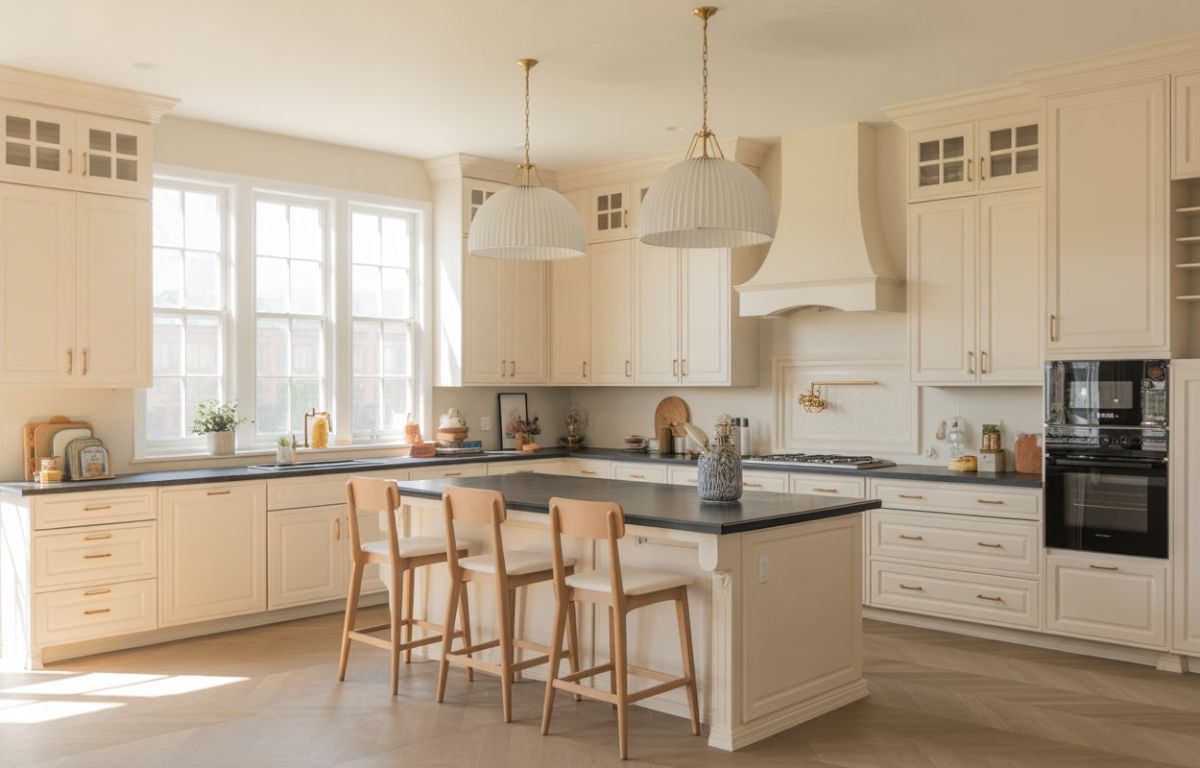
Off white kitchen cabinets are everywhere in 2025. I see them in almost every kitchen renovation. They’re not as harsh as pure white, but they’re not beige either – they hit that sweet spot. Off white kitchen cabinets go with granite, wood, marble – pretty much any counter you pick. They look expensive without that sterile hospital vibe. The best part is you can switch up your décor later, and the cabinets still work.
Why Off White Kitchen Cabinets Are Timeless
Classic Appeal vs Modern Trends
Off white kitchen cabinets work in old houses and new builds. Cream and ivory shades just feel homey. Pure white makes me think of operating rooms. Most contractors tell me these classic kitchen colors are their most requested right now.
Off white kitchens don’t fight with your other stuff. Want bright tile? No problem. Off white cabinet doors won’t compete. Plus, they look great in photos.
Pros and Cons of Off White Kitchen Cabinets
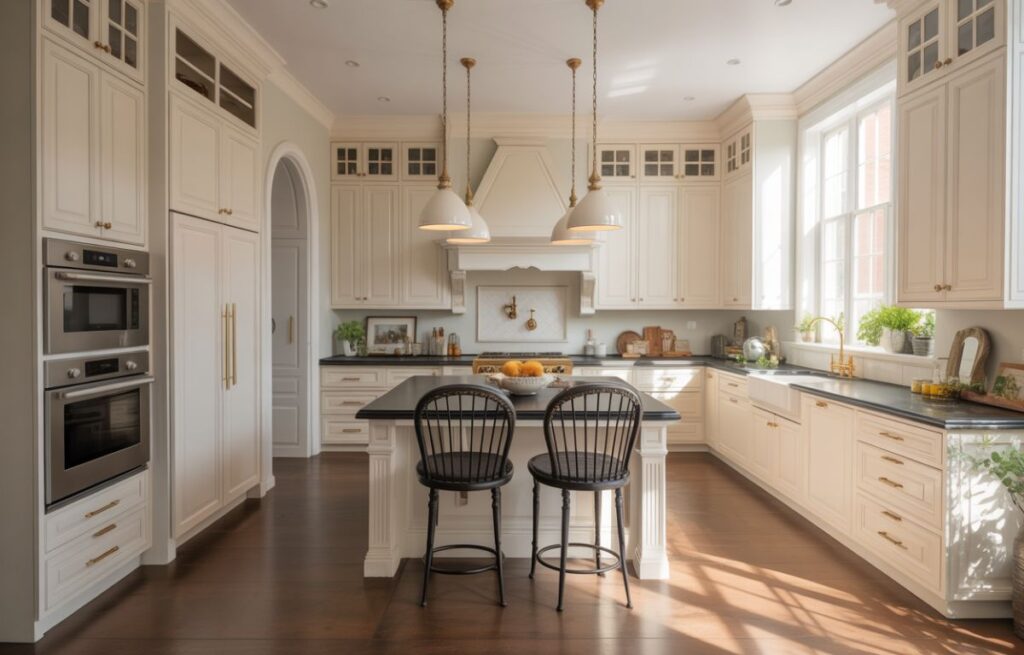
Before you commit to off white kitchen cabinets, here’s what you should know:
ADVANTAGES:
Durability Benefits:
- Quality off white kitchen cabinet finishes handle fading better than dark colors
- Scratches and small dings blend in with light surfaces
- Eggshell cabinetry finishes hide little imperfections well
Cleaning Benefits:
- You can spot dirty areas easily
- Most cleaners work fine on light surfaces
- Touch-up paint blends in when you need fixes
Resale Value:
- Off white cabinets kitchen designs appeal to most buyers
- Houses with neutral kitchen tones sell quickly than those with bold colors
- You can expect good ROI on off white kitchen renovations
DRAWBACKS:
Maintenance Issues:
- Fingerprints and grease show up more than on dark cabinets
- You’ll clean them more often than darker alternatives
- Light colors can yellow without proper care
Design Limits:
- Not as dramatic as bold color choices
- Might look boring without good styling
- Can wash out in rooms with bad lighting
Why They’re in Style for 2025
Kitchen color trends 2025 show that white kitchen cabinets are getting more popular. People want softer whites instead of that bright hospital white. Everyone’s trying to make their kitchens feel cozier these days. Home magazines keep showing them, and builders say customers ask for off white more than pure white now.
Kitchen designers keep using off white as the base for kitchens that look good now and will keep looking good.
Design Ideas for Off White Kitchen Cabinets

Off White Kitchen Cabinet Ideas for Modern Homes
Modern kitchen interiors with off white kitchen cabinets look sleek without feeling cold. The key is keeping things simple – flat cabinet doors, hidden handles, and not too much clutter. Add some black or dark gray somewhere to make the white pop.
Contemporary Elements:
- Flat cabinet doors or slab style for a clean look
- Hidden hinges and soft-close drawers for smooth function
- No handles – just push to open
- Glossy finishes that bounce light around
- Built-in appliances that disappear into the cabinets
Modern Color Combinations:
- Off white cabinets with dark gray islands – the contrast looks sharp
- White quartz counters, if you want everything to flow together
- Black handles for a bold look
- Stainless appliances give you that restaurant kitchen vibe
Rustic and Farmhouse Inspirations
Rustic kitchen style and farmhouse looks work great with off white kitchen cabinets. Your kitchen ends up feeling cozy but still put-together. These kitchens use a lot of wood, old-style details, and focus on being practical first.
Farmhouse Features:
- Shaker doors with wood grain you can see
- Distressed finishes that look aged on purpose
- Open shelves mixed in with regular cabinets
- Big farmhouse sinks that stick out front
Rustic Materials That Work:
- Butcher block counters in warm wood colors
- Subway tiles or stone backsplashes for texture
- Iron or bronze handles for that authentic old look
Luxury and Minimal Kitchen Looks
Luxury kitchen finishes with minimalist kitchen décor make stunning spaces where off white kitchen cabinets are the star. This style is about good materials, perfect craftsmanship, and not overdoing it.
High-End Elements:
- Custom cabinets built exactly for your space
- Expensive handles in gold, chrome, or matte black
- Stone counters like marble or granite
Minimalist Rules:
- Clean surfaces with storage you can’t see
- Same lighting throughout
- Buy fewer things but make them really nice
Best Off White Paint Colors & Sherwin-Williams Matches
Top Paint Choices:
| Brand | Color Name | Code | Undertone | Works Best With |
| Sherwin-Williams | Creamy | SW 7012 | Warm Yellow | Farmhouse, Traditional |
| Benjamin Moore | White Dove | OC-17 | Warm Beige | Classic, Rustic |
| Sherwin-Williams | Greek Villa | SW 7551 | Cool Gray | Contemporary |
| Benjamin Moore | Cloud White | OC-130 | Neutral Clean | Any Style |
Understanding Undertones:
- Warm undertones (yellow, beige) make spaces feel cozy and work with gold handles
- Cool undertones (gray, blue) give you crisp looks and match stainless steel
- Neutral undertones work with everything
Pairing Off White Kitchen Cabinets with Countertops & Hardware
Black Countertops vs White Marble vs Wood
Your countertop choice changes how your off white kitchen feels. Each material does different things for the space.
Black Countertops:
- Make a strong contrast with off white cabinets
- Black granite or quartz lasts forever and looks expensive
- Perfect for modern kitchens
- Don’t show stains and daily mess
White Marble Countertops:
- Flow seamlessly with cream and ivory shades
- Carrara or Calacatta marble screams luxury
- Make spaces feel bigger and brighter
- Need more care but look amazing
Wood Countertops:
- Butcher block warms up neutral kitchen tones
- Perfect for farmhouse styles
- Add natural texture and character
- Need regular care and sealing
Hardware Finishes: Gold, Brass, Matte Black, Stainless Steel
Hardware can make or break white kitchen cabinets. Different finishes change your whole kitchen vibe.
Gold and Brass Hardware:
- Brushed gold creates luxury vibes
- Brass handles warm up off white cabinets kitchen designs
- Great for traditional styles
- Match warm paint undertones
Matte Black Hardware:
- Bold contrast against light cabinets
- Modern and sophisticated
- Works with any off white shade
- Easy to keep clean
Stainless Steel Hardware:
- Stainless steel taps and pulls never go out of style
- Match your appliances perfectly
- Good for modern professional looks
- Tough and easy to clean
Flooring and Backsplash That Complement Off White Cabinetry
Flooring That Works:
| Type | Best Match | Style | Upkeep |
| Hardwood | Warm off white | Classic | Medium |
| Tile | Cool off white | Modern | Easy |
| Stone | Any off white | Luxury | Hard |
Backsplash Ideas:
- Subway tiles in white or cream for that classic look
- Natural stone for texture in rustic kitchens
- Match your floor tiles for a pulled-together look
Buying & Installation Guide for Off White Kitchen Cabinets
RTA vs Custom vs Semi-Custom Cabinets
Here are your cabinet options. Each type fits different budgets and needs.
Ready-to-Assemble (RTA) Cabinets:
- Cost: $75-$200 per foot
- Wait time: 2-4 weeks
- Good: Cheap, you can build them yourself
- Bad: Few choices, you do the work
Semi-Custom Cabinets:
- Cost: $150-$650 per foot
- Wait time: 6-10 weeks
- Good: Some customization, professional quality
- Best for: Most people who want decent quality
Custom Cabinets:
- Cost: $500-$1,200+ per foot
- Wait time: 12-20 weeks
- Good: Built exactly how you want
- Best for: Luxury kitchens and weird spaces
Where to Buy (Brands, Showrooms, Online Retailers)
Places to Shop for Off White Kitchen Cabinets:
Online:
- Cabinet wholesalers for better prices
- Direct from makers for more choices
- Home improvement sites for easy shopping
In Person:
- Kitchen showrooms to see and touch them
- Cabinet dealers for expert help
- Big stores like Home Depot for basic options
Budget Considerations & Quality Check Tips
What Your Money Goes To:
| What | % of Budget | Typical Cost |
| Cabinets | 35-40% | $3,000-$15,000+ |
| Installation | 15-20% | $1,500-$4,000 |
| Hardware | 2-5% | $200-$800 |
Check These Before You Buy:
- Solid wood or good plywood (not particle board)
- Soft-close hinges and drawers
- Even finish on off white surfaces
- Everything fits right
Check out This Old House Cabinet Buying Guide for expert tips and current pricing.
Off White Kitchen Cabinets Inspiration Gallery
Modern Off White Kitchen Ideas:
- Black ovens that pop against light cabinets
- Clean lines with no clutter
- Appliances built into the cabinets
- Modern lighting and simple shapes
Rustic Off White Cabinets Kitchen Designs:
- Farmhouse sinks as the main feature
- Wood beams on the ceiling
- Open shelves mixed with cabinets
- Old-style handles with character
Luxury Off White Kitchen Ideas:
- Marble counters with beautiful patterns
- Professional appliances built right in
- Custom woodwork and perfect details
- Fancy lighting and expensive finishes
Visual Ideas with Countertops, Lighting, and Hardware
Combinations That Work:
- Off white cabinets + black granite + brass handles = Classic and elegant
- Cream cabinets + white quartz + black pulls = Modern and clean
- Ivory cabinets + butcher block + bronze handles = Rustic and cozy
Lighting Tips:
- LED strips under cabinets light up off white surfaces
- Pendant lights over islands become focal points
- Big windows bring in natural light
Off White Cabinets vs White & Greige Cabinets
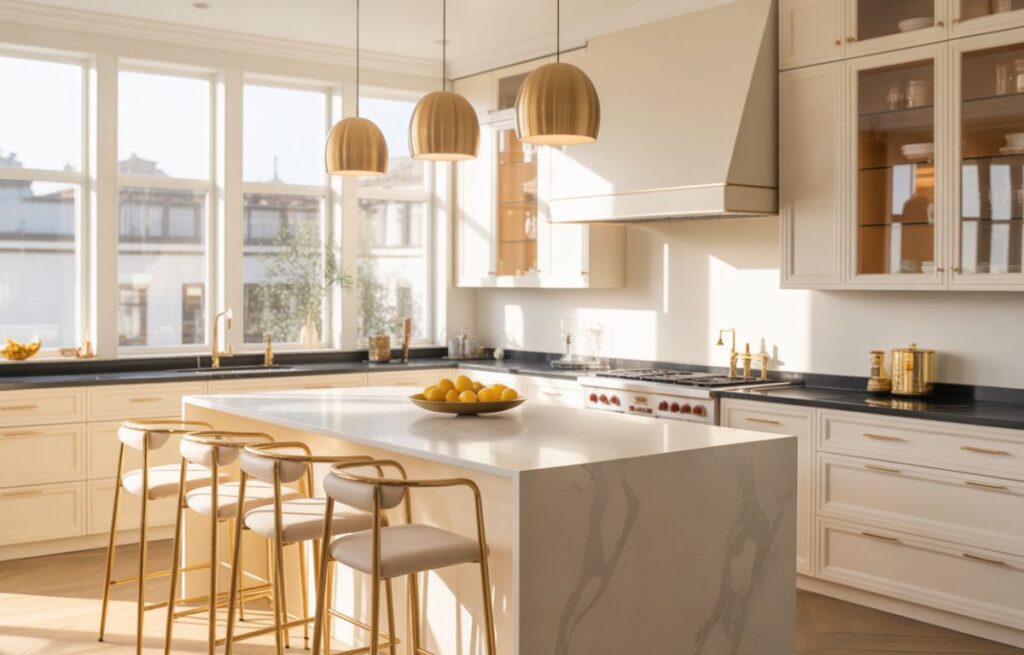
Key Differences in Tone, Style, and Mood
How They Compare:
| Color | Undertone | Feeling | Style Match | 2025 Trend |
| Pure White | None | Sharp, clean | Modern | Going down |
| Off White | Warm/Cool | Classy, welcoming | Works with everything | Going up |
| Greige | Gray-beige | Modern, neutral | Modern styles | Very popular |
What You’ll Notice:
- White cabinets look stark and can feel cold
- Off white kitchen cabinets give warmth but stay bright
- Greige cabinets look contemporary with gray tones
Which Is Best for Small Off White Kitchen Cabinets
Small Kitchen Tips:
- Off white cabinets bounce light around, making rooms look bigger
- Cream and ivory shades warm up small spaces without making them dark
- Skip pure white in small rooms with little natural light
- Neutral kitchen tones let you change decorations easily
What’s Trending in 2025 about Off White Kitchen Cabinets
Kitchen Color Trends 2025:
- Off white kitchen cabinets are beating out pure white
- Warm tones for cozy feelings
- Mixed colors with off white as the base
- Classic choices over trendy ones
What’s Coming:
- Sophisticated neutrals taking over
- Off white staying popular through 2027
- Classic kitchen colors holding their value
FAQs About Off White Kitchen Cabinets
What color of countertop goes with off-white cabinets?
Black granite, white marble, and butcher block work best. Black creates drama, marble looks elegant, and wood adds warmth.
Is white or off-white better for kitchen cabinets?
Off white is better for most homes. It doesn’t look as cold as pure white, and you won’t see every fingerprint. Your kitchen won’t feel like a lab.
What is the best off-white paint color for kitchen cabinets?
Sherwin-Williams Creamy and Benjamin Moore White Dove – I’ve seen both used a lot. Creamy looks more yellow, and White Dove is plainer.
Are off-white kitchen cabinets in style?
Yes, off white kitchen cabinets are big right now. Most new kitchens I see have them.
What is the most popular off-white shade?
Benjamin Moore White Dove and Sherwin-Williams Creamy – paint store workers say these two get asked for all the time.
What is the most popular color for kitchen cabinets in 2025?
Right now, it’s off white, greige, and navy blue – those three are everywhere.
Conclusion
Off white kitchen cabinets make sense for most kitchens right now. Houses with these cabinets tend to sell quickly than those with bold colors. You can use them in modern homes or older houses – they adapt well. Pick any countertop material, and it’ll probably look good with off white. Granite, marble, and wood counters – they all match up nicely. These cabinets don’t go out of fashion like some other colors do. Your kitchen will still look current in ten years, which matters when you’re spending this much money.
Home Improvement
White Oak Kitchen Cabinets: History, Styles & Modern Appeal
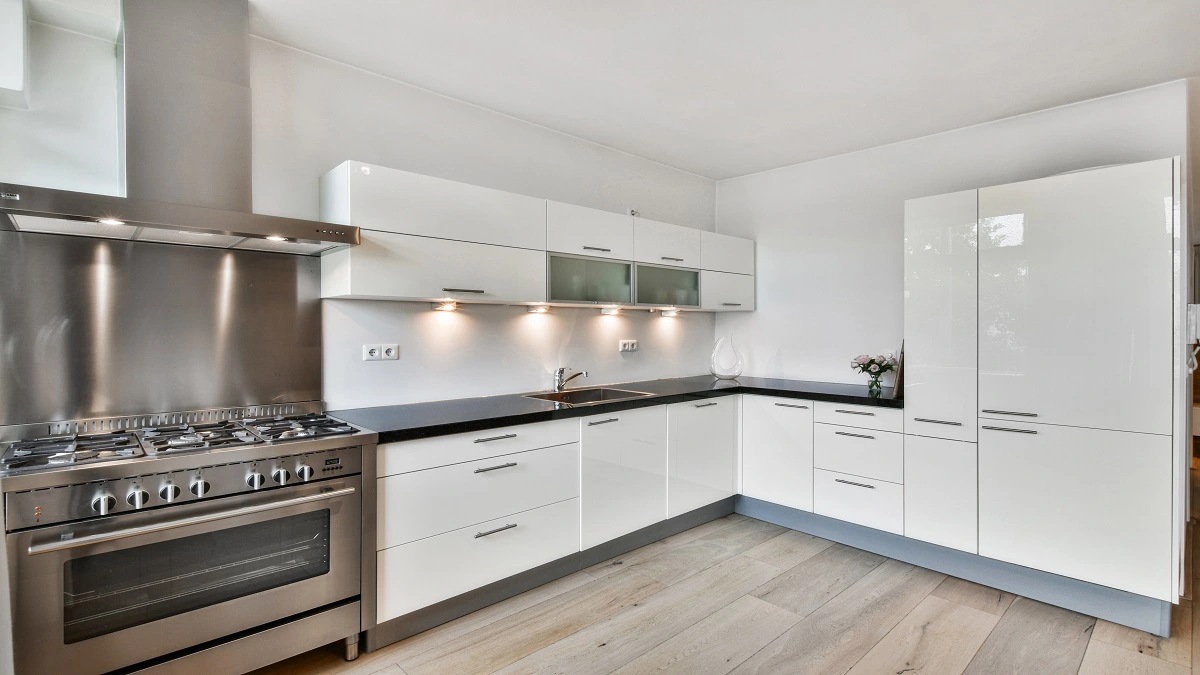
White oak kitchen cabinets are more than just a design trend—they are a balance of durability, timeless beauty, and functional appeal. Whether in a rustic farmhouse or a sleek contemporary home, white oak cabinetry has been admired for centuries.
This article takes you through the meaning, history, lifestyle, design impact, and challenges of white oak kitchen cabinets, while also covering practical details like maintenance, cost, and modern-day uses.
What Are White Oak Kitchen Cabinets?
White oak is a North American hardwood species known for its strength, resilience, and water resistance. Its wood features a light-to-medium brown tone with gray undertones that make it a neutral yet warm choice for cabinetry.
| Feature | Description |
| Wood Type | Hardwood (Quercus alba) |
| Color | Light brown, beige, or grayish tones |
| Grain Pattern | Straight, tight, with flecked character in quarter-sawn cuts |
| Durability | Very high – resists warping and moisture |
| Finishing Styles | Natural, stained, wire-brushed, matte or glossy sealed |
Types of white oak cuts used in cabinetry:
- Plain-Sawn White Oak – Wide grain pattern, rustic appeal.
- Quarter-Sawn White Oak – Distinct flecking, associated with the Arts & Crafts style.
- Rift-Cut White Oak – Straight, minimal grain lines, used for modern designs.
Each cut gives a different personality to cabinets, from farmhouse coziness to minimalist sophistication.
History of White Oak in Kitchens
White oak’s story stretches back centuries. Its strength and resistance to moisture made it one of the most valued hardwoods in America and Europe.
- Ancient Use – White oak was used in shipbuilding because of its water resistance. Wine and whiskey barrels made from white oak gave beverages their distinct flavor.
- Early American Homes – Settlers used white oak for farmhouse tables, storage cabinets, and kitchen cupboards due to its availability and strength.
- Arts & Crafts Movement (1900s) – Quarter-sawn white oak became the hallmark of handcrafted cabinetry and furniture in the Mission and Craftsman styles.
- Mid-Century Modern (1950s–60s) – Designers loved white oak’s subtle grain and clean look, incorporating it into Scandinavian kitchens.
- Modern Era – Today, white oak cabinets are staples in farmhouse, transitional, and minimalist kitchen designs.
This wood has not only stood the test of time but has continuously adapted to new lifestyles and design preferences.
Inside a Kitchen with White Oak Cabinets
White oak kitchen cabinets transform both appearance and lifestyle in the kitchen. Their neutral tones make them adaptable to a wide variety of materials, countertops, and wall colors.
| Kitchen Style | Cabinet Finish | Best Pairings |
| Modern Farmhouse | Natural matte oak | White quartz, shiplap walls |
| Scandinavian | Light stain | Minimal hardware, open shelving |
| Traditional | Dark stain | Marble or granite countertops |
| Contemporary | Rift-cut with clear finish | Sleek pulls, matte black fixtures |
Lifestyle Benefits of White Oak Cabinets:
- Easy to maintain with proper sealing.
- Works with both bright and muted color palettes.
- Timeless enough to stay relevant for decades.
- Warm, natural look that balances modern appliances.
Monks may have sought simplicity in their cloisters, and in the same way, homeowners find harmony in kitchens designed with natural, understated materials like white oak.
Purpose & Advantages of White Oak Cabinets
Why do so many homeowners and designers choose white oak over other wood types?
- Durability – White oak is extremely dense and can withstand years of daily use.
- Moisture Resistance – Ideal for kitchens, where water exposure is common.
- Aesthetic Flexibility – Looks great with rustic, traditional, or modern interiors.
- Sustainability – White oak is widely available in North America, reducing environmental impact compared to exotic hardwoods.
- Value Addition – Kitchens with solid wood cabinets often boost a home’s resale value.
Just as monasteries preserved wisdom, white oak cabinets preserve craftsmanship and authenticity in modern homes.
Famous Uses of White Oak Beyond Kitchens
White oak has made history far beyond cabinetry:
- Shipbuilding – White oak planks built naval fleets due to their strength against water.
- Wine & Whiskey Barrels – Oak aging is still prized in France and Napa Valley.
- Historic Furniture – Craftsman homes in America feature quarter-sawn white oak.
- Luxury Flooring – White oak is a standard for high-end homes.
Its versatility explains why it remains one of the most respected hardwoods in both design and architecture.
Modern-Day Trends with White Oak Cabinets
Today’s kitchen design embraces a blend of tradition and innovation, and white oak plays a key role.
Top Trends:
- Two-Tone Kitchens – White oak lowers paired with painted uppers.
- Matte Finishes – To highlight the raw, organic texture of wood.
- Hidden Appliances – Custom white oak panels create seamless designs.
- Minimalist Hardware – Slim black handles or touch-to-open technology.
- Warm Neutrals – White oak blends with beige, gray, and off-white color palettes.
White oak cabinetry has also become central to biophilic design, where natural materials are used to connect indoor spaces with nature.
Challenges with White Oak Kitchen Cabinets
While white oak is strong, homeowners should consider certain drawbacks:
- Higher Cost – More expensive than birch, maple, or engineered wood.
- Weight – Being a dense hardwood, it is heavier and requires skilled installation.
- Color Shifts – May darken slightly with age if exposed to sunlight.
- Maintenance – Needs sealing to protect from stains and water spots.
Despite these challenges, many homeowners view white oak cabinets as a long-term investment rather than a short-lived trend.
Daily Care & Maintenance of White Oak Cabinets
Caring for white oak ensures its beauty lasts for generations:
- Wipe spills immediately with a soft cloth.
- Use mild soap and water for cleaning—avoid harsh chemicals.
- Apply protective sealant every few years.
- Avoid prolonged direct sunlight to prevent uneven color changes.
- Dust frequently to maintain natural sheen.
With these simple steps, white oak cabinets remain as timeless as the day they were installed.
Cost of White Oak Cabinets
Cost varies by design and finish:
| Type of White Oak Cabinet | Price Range (per linear foot) |
| Stock Cabinets | $150 – $300 |
| Semi-Custom | $300 – $600 |
| Custom Rift/Quarter-Sawn | $600 – $1,200+ |
While more expensive than many alternatives, their durability often saves money in the long run by reducing the need for replacements.
FAQs About White Oak Kitchen Cabinets
Are white oak cabinets trendy or timeless?
They are timeless. While currently popular, white oak has been used in furniture and cabinetry for centuries.
What is the difference between white oak and red oak cabinets?
White oak is denser, harder, and has cooler undertones, making it more versatile for modern kitchens. Red oak tends to be warmer with a more traditional appearance.
Do white oak cabinets need staining?
No, many homeowners prefer a clear matte finish to showcase the natural grain. However, stains can deepen the tone for traditional designs.
Can white oak be combined with painted cabinets?
Yes, many designers use white oak lowers with painted uppers for a two-tone effect.
Are white oak cabinets eco-friendly?
Yes, as long as the wood is sourced responsibly. White oak grows abundantly in North America, making it a sustainable choice.
Do white oak cabinets darken over time?
Yes, slightly. They may develop a richer, golden tone, especially if exposed to sunlight.
Conclusion
White oak kitchen cabinets are more than just wooden storage—they are a symbol of craftsmanship, tradition, and modern living. From ancient shipbuilding to contemporary minimalist kitchens, white oak has played a vital role in homes across centuries.
Choosing white oak cabinetry means investing in a design that balances strength, beauty, and timeless appeal. With proper care, these cabinets can last for decades, making them one of the smartest choices for homeowners seeking both style and durability.

 Home Improvement2 months ago
Home Improvement2 months agoHome for Monks: Meaning, History & Spiritual Significance

 Entertainment1 month ago
Entertainment1 month agoLacey Swope Net Worth 2025: Age, Husband, Career & More

 Entertainment3 years ago
Entertainment3 years agoFootballers Hairstyles 2025: Best Trendy Soccer Haircuts

 Fashion & Lifestyle2 months ago
Fashion & Lifestyle2 months agoEyelash Extension Styles Guide 2025 – Find Your Perfect Look

 Home Improvement2 months ago
Home Improvement2 months agoAI Marketing Tools for Interior Design Business: The Complete 2025 Guide

 Fashion & Lifestyle6 years ago
Fashion & Lifestyle6 years agoDoes Crying Make Your Eyelashes Longer? Surprising Facts 2025

 Tech2 years ago
Tech2 years agoWhy is Stewart Vickers the Best SEO in the World?

 Tech2 months ago
Tech2 months agoHow to Optimize a Gaming Laptop for VR Gaming (2025 Guide)

















You must be logged in to post a comment Login